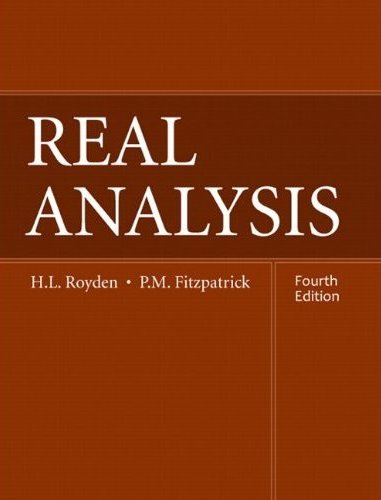
Henri Lebesgue, 1875-1941

COURSE: MATH 5210-001
TIME: 9:45-11:05 TR, PLACE: Room 205 Gilbreath Hall
INSTRUCTOR: Dr. Robert Gardner, OFFICE: Room 308F of Gilbreath Hall
OFFICE HOURS: 10:15-11:15 MWF PHONE: 439-6979 (Math Office 439-4349)
E-MAIL: gardnerr@etsu.edu
WEBPAGE: http://faculty.etsu.edu/gardnerr/gardner.htm
TEXT: Real Analysis, Fourth Edition, by H.L. Royden and P.M. Fitzpatrick, Prentice Hall (2010).

ABOUT THE COURSE: This class offers a standard introduction to the theory of functions of a real variable from the measure theoretic perspective. As commented on page 1 of the third edition of Real Analysis, we will cover "a portion of the material that every graduate student in mathematics must know." Whereas the undergraduate real analysis class presents the results of calculus from a rigorous perspective, we will introduce fundamentally new ideas which are basic extensions of the results from calculus. In particular, we will put a weight or "measure" on certain sets of real numbers. This measure will be used to define a new type of integral called the Lebesgue integral. Recall that a function is Riemann integrable if and only if it is discontinuous on a "small" set (namely, a set of measure zero). The Lebesgue integral is much more flexible and will allow us to integrate a much larger class of functions. In addition, we will have a number of "convergence theorems" related to the Lebesgue integral, which are not true in the setting of Riemann integration. The fourth edition of Real Analysis states on page x that "The general theory of measure and integration was born in the early twentieth century. It is now an indispensable ingredient in remarkably diverse areas of mathematics, including probability theory, partial differential equation, functional analysis, harmonic analysis, and dynamical systems. Indeed, it has become a unifying concept."
GRADING: We will have two tests (T1 and T2) and homework (HW) will be taken up a regular intervals (weekly). Your average will be computed as follows:
A NOTE ABOUT HOMEWORK: While I suspect that you may work with each other on the homework problems (in fact, I encourage you to), I expect that the work you turn in is your own and that you understand it. Several of the homework problems are fairly standard for this class, and you may find proofs online. However, the online proofs may not be done with the notation, definitions, and specific methods which we are developing and, therefore, are not acceptable for this class. Your homework grade will also reflect how clearly you write up your solution and document your claims.
TENTATIVE OUTLINE:
The Riemann-Lebesgue Theorem
Riemann integral, measure zero set, oscillation, uniform convergence, convergence theorems.
Chapter 1: The Real Numbers (Section 4)
σ-algebras of sets, Borel sets, Fσ and Gδ sets.
Chapter 2: Lebesgue Measure
outer measure, measurable sets, inner approximation, Lebesgue measure, nonmeasurable set, Banach-Tarski Paradox, Cantor set and Cantor-Lebesgue Function.
Axiom of Choice: More Axiom of Choice and the Banach-Tarski Paradox.
Chapter 3: Lebesgue Measurable Functions
measurable functions, characteristic functions, approximation, Littlewood's principles, Egoroff's Theorem, Lusin's Theorem.
Chapter 4: Lebesgue Integration
Riemann integral, step functions, simple functions, Lebesgue integral of a
bounded function, Bounded Convergence Theorem, Fatou's Lemma, Monotone
Convergence Theorem, Lebesgue Dominated Convergence Theorem, general Lebesgue
integral, uniform integrability.
IMPORTANT DATES:
| |
|||
Problem A. Show that if E is measurable and a subset of P, then the measure of E is zero.
Problem B. Show that if A is any set with positive outer measure, then there is a nonmeasurable subset of A.
Problem C. Give an example of a disjoint sequence of sets for which the outer measure of the union is strictly less than the sum of the outer measures. Use set P and explain.
Return to
Bob Gardner's home page
Last updated: December 12, 2012.